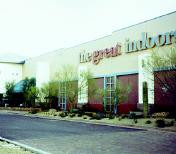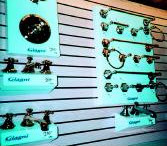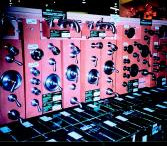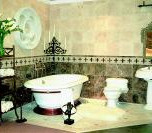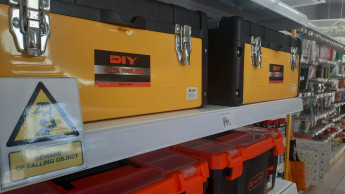Two major American DIY retail chains are trying their hand at somewhat different concepts
Entrances to Expo Design Centers affirm their Home Depot parentage.
So far only two chains are occupying this ground, though with very different approaches. One is Home Depot, whose Expo Design Center concept is the older, having been in existence for nearly six years. A more recent entry to this exclusive market is Sears, whose pioneer Great Indoors store opened three years ago. Today the company operates 16 outlets, with three or four more scheduled to be opened this year and a controlled growth plan of about three to five stores a year.
The Great Indoors entrances do not bear any Sears identity.
Both are large stores located in shopping centres situated in or near high-income areas. Both are seeking customers willing to spend sizeable amounts to remodel kitchens and bathrooms particularly. The similarities almost end there.
The Great Indoors, which does not identify itself as a Sears division, is merchandised to bring in more female traffic, and to generate more store traffic on a regular basis by merchandising impulse and lower-cost merchandise such as housewares, some gifts, pillows, bedding, etc.. It also features televisions and a large kitchen appliance section, capitalising on Sear’s strength in major appliances. Its paint department is another major difference, since paint and decorating are lower-cost modernisation efforts. It conducts classes, for example, on faux finishing techniques and so on.
Differences in merchandise presentation: Expo Design highlights taps and bathroom accessories on a wall display…
Depot’s Expo Design Centers, on the other hand, concentrate entirely on serving the project-oriented customer. The stores are attractive, but lack any merchandising flair when compared with the sales floor at Great Indoors, where there is any amount of such flair.
...Great Indoors does the same, but also stocks take-home items.
John W. Herbert, former head of Knauber and today executive director of the BHB, who ran Expo Design Center’s Western division for a year, said recently that the company would benefit more by lowering its price-points somewhat and by catering to a slightly less affluent target group.
Both carry some everyday DIY merchandise (taps and hardware, etc), but here again none of it is basic, lower cost merchandise found in a Home Depot, Ace or Lowe’s. Taps range up to several hundred dollars; entry hardware, which sells across the counter in hardware shops and DIY stores at prices ranging from US $ 15 to $ 30, can cost as much as $ 200. Mass displays are not used either. Instead, merchandise is stylishly displayed to enhance its visual appeal (and perhaps to justify its pricing).
The showroom displays at Expo Design are very different from those found in Home Depot stores.
Is the Design Center concept working? Under new CEO Bob Nardelli, Home Depot has slowed its rate of growth and there are rumours that other changes may be in the offing — perhaps appealing to a less affluent audience, as Herbert suggested?
Sears has also been cautious in opening Great Indoors stores. Site selection is vital; the giant stores (14 000 m2 or more) require a major investment and must be surrounded by stores that will help drive traffic to the area. Its store in Scottsdale, Arizona, which opened more than two years ago, is now benefiting from a nearby Lowe’s, as well as Linens ’N Things and other specialty stores that attract women.
But both chains prove that there is a high-end market segment that is not being adequately served by traditional hardware shops and DIY stores.
